Report: IT's Impact on the Healthcare Sector, University Name, 2024
VerifiedAdded on 2023/04/23
|15
|3436
|488
Report
AI Summary
This report, based on a literature review, investigates the multifaceted impacts of Information Technology (IT) on the healthcare sector. It examines how IT, including electronic health records (EHRs) and computerized provider order entry (CPOE), improves the effectiveness of care delivery, enhances healthcare service quality, and prevents avoidable medical errors. The report highlights the role of IT in lowering healthcare costs, increasing administrative competences, and expanding access to affordable care. The methodology involved a structured literature search using databases like PubMed and CINAHL, focusing on articles published from 2014 onwards. Key findings indicate that IT, especially CPOE, reduces adverse drug events and medication errors, enhancing patient safety. The report also discusses the challenges of IT implementation, such as high costs and the need for adequate resources, particularly in rural areas, while emphasizing the potential for IT to transform healthcare practices and improve patient outcomes. The report concludes by discussing the advantages of IT in healthcare, including improved patient outcomes, reduced costs, and better operational efficiency.
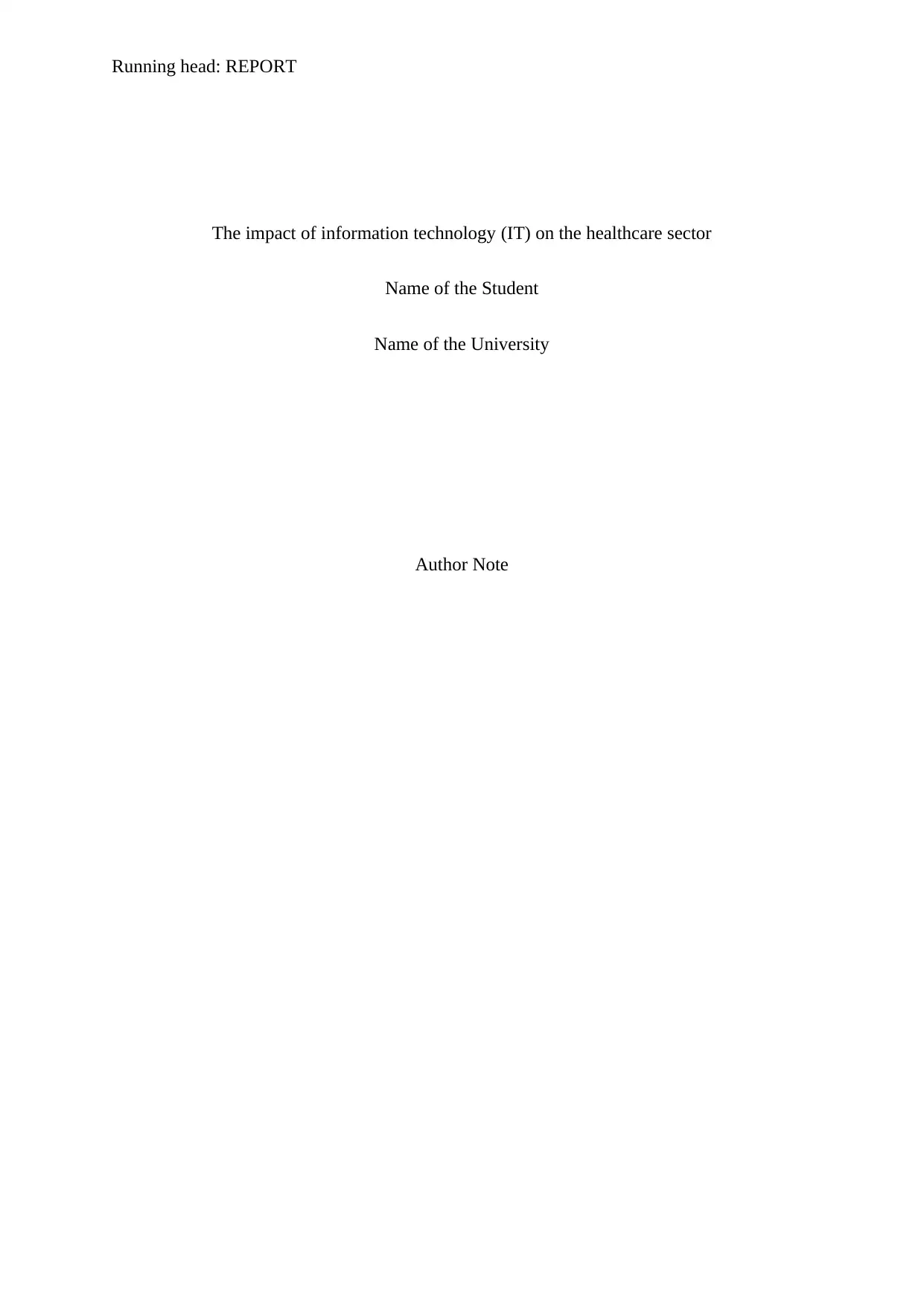
Running head: REPORT
The impact of information technology (IT) on the healthcare sector
Name of the Student
Name of the University
Author Note
The impact of information technology (IT) on the healthcare sector
Name of the Student
Name of the University
Author Note
Paraphrase This Document
Need a fresh take? Get an instant paraphrase of this document with our AI Paraphraser
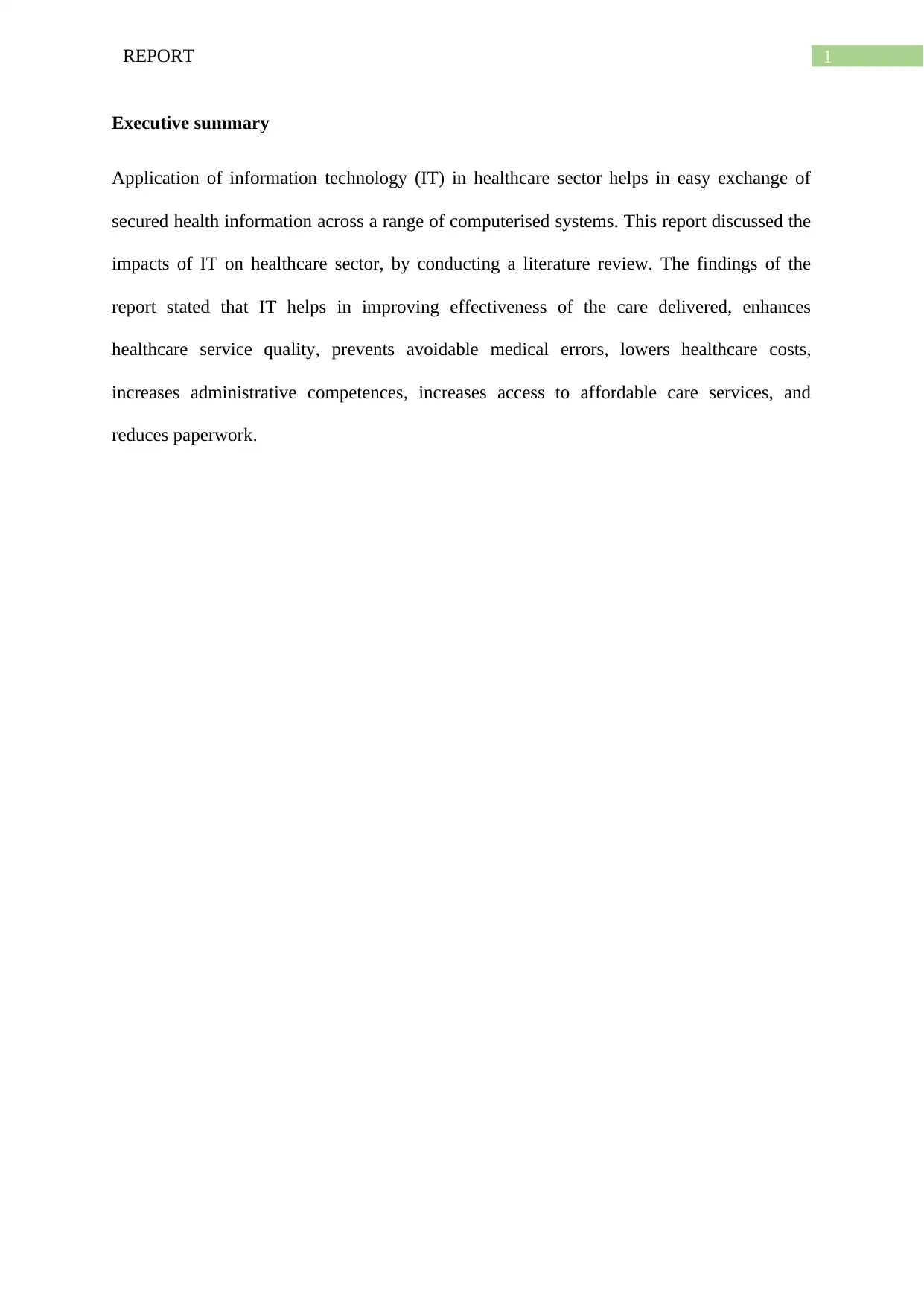
1REPORT
Executive summary
Application of information technology (IT) in healthcare sector helps in easy exchange of
secured health information across a range of computerised systems. This report discussed the
impacts of IT on healthcare sector, by conducting a literature review. The findings of the
report stated that IT helps in improving effectiveness of the care delivered, enhances
healthcare service quality, prevents avoidable medical errors, lowers healthcare costs,
increases administrative competences, increases access to affordable care services, and
reduces paperwork.
Executive summary
Application of information technology (IT) in healthcare sector helps in easy exchange of
secured health information across a range of computerised systems. This report discussed the
impacts of IT on healthcare sector, by conducting a literature review. The findings of the
report stated that IT helps in improving effectiveness of the care delivered, enhances
healthcare service quality, prevents avoidable medical errors, lowers healthcare costs,
increases administrative competences, increases access to affordable care services, and
reduces paperwork.
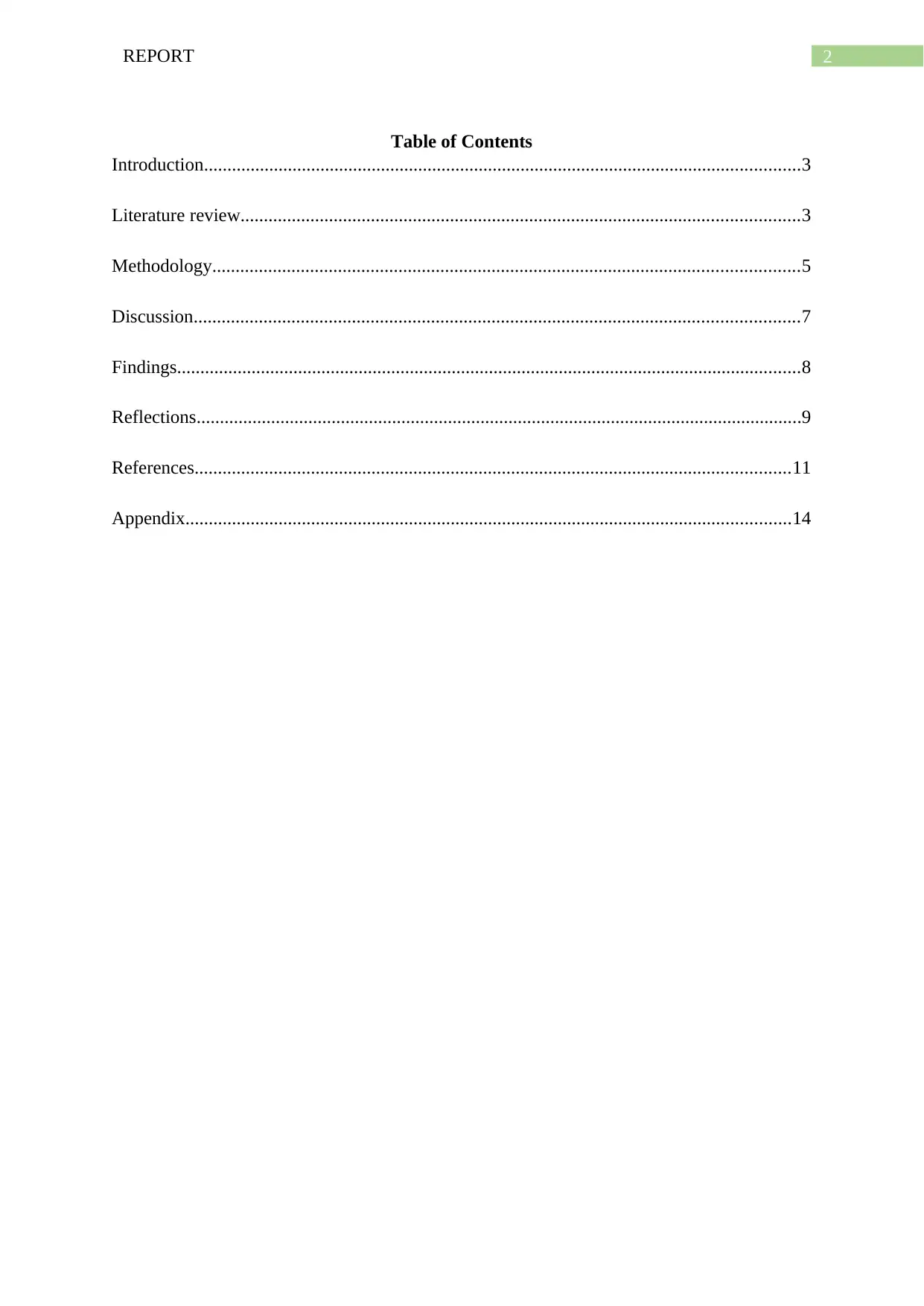
2REPORT
Table of Contents
Introduction................................................................................................................................3
Literature review........................................................................................................................3
Methodology..............................................................................................................................5
Discussion..................................................................................................................................7
Findings......................................................................................................................................8
Reflections..................................................................................................................................9
References................................................................................................................................11
Appendix..................................................................................................................................14
Table of Contents
Introduction................................................................................................................................3
Literature review........................................................................................................................3
Methodology..............................................................................................................................5
Discussion..................................................................................................................................7
Findings......................................................................................................................................8
Reflections..................................................................................................................................9
References................................................................................................................................11
Appendix..................................................................................................................................14
⊘ This is a preview!⊘
Do you want full access?
Subscribe today to unlock all pages.

Trusted by 1+ million students worldwide
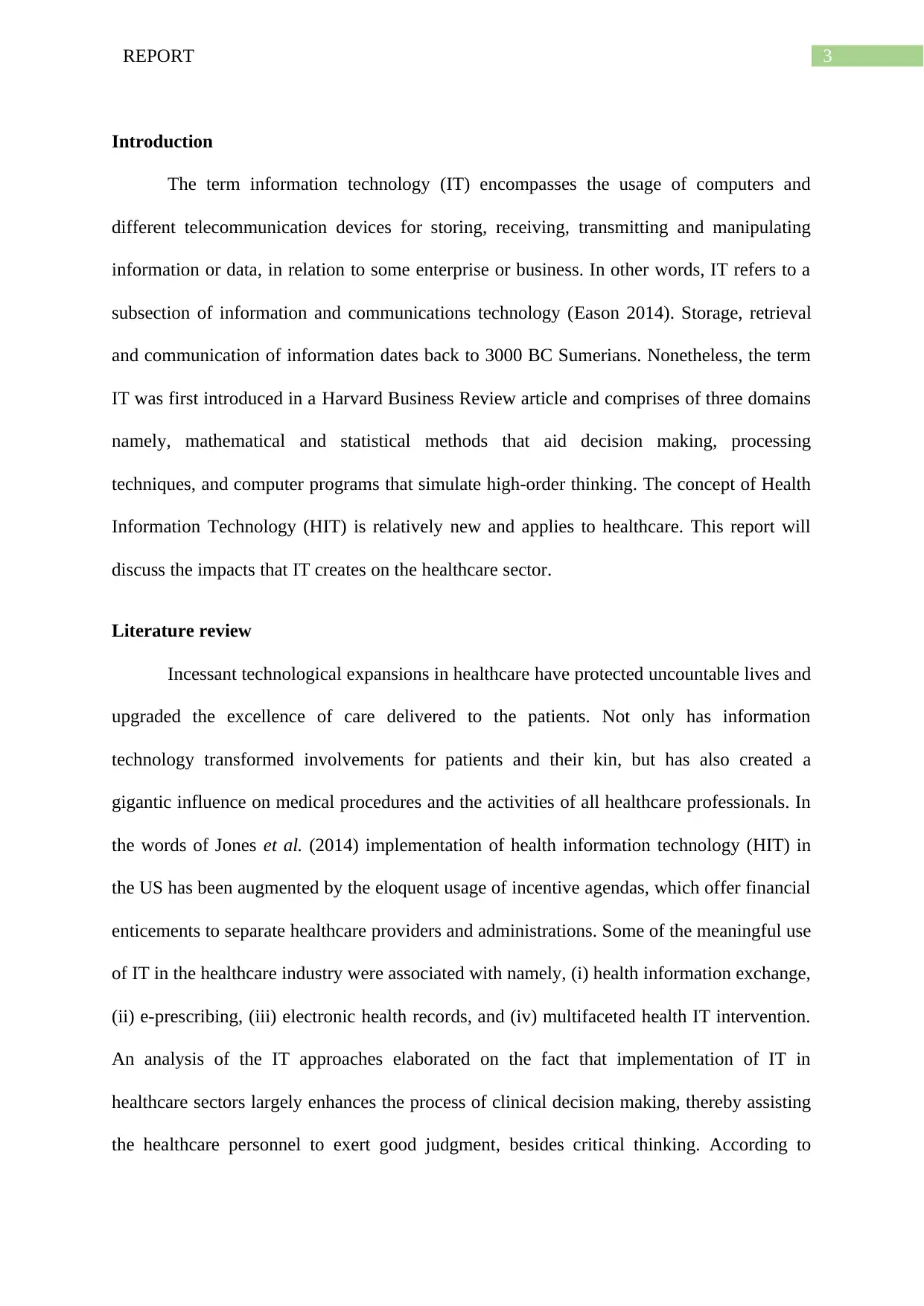
3REPORT
Introduction
The term information technology (IT) encompasses the usage of computers and
different telecommunication devices for storing, receiving, transmitting and manipulating
information or data, in relation to some enterprise or business. In other words, IT refers to a
subsection of information and communications technology (Eason 2014). Storage, retrieval
and communication of information dates back to 3000 BC Sumerians. Nonetheless, the term
IT was first introduced in a Harvard Business Review article and comprises of three domains
namely, mathematical and statistical methods that aid decision making, processing
techniques, and computer programs that simulate high-order thinking. The concept of Health
Information Technology (HIT) is relatively new and applies to healthcare. This report will
discuss the impacts that IT creates on the healthcare sector.
Literature review
Incessant technological expansions in healthcare have protected uncountable lives and
upgraded the excellence of care delivered to the patients. Not only has information
technology transformed involvements for patients and their kin, but has also created a
gigantic influence on medical procedures and the activities of all healthcare professionals. In
the words of Jones et al. (2014) implementation of health information technology (HIT) in
the US has been augmented by the eloquent usage of incentive agendas, which offer financial
enticements to separate healthcare providers and administrations. Some of the meaningful use
of IT in the healthcare industry were associated with namely, (i) health information exchange,
(ii) e-prescribing, (iii) electronic health records, and (iv) multifaceted health IT intervention.
An analysis of the IT approaches elaborated on the fact that implementation of IT in
healthcare sectors largely enhances the process of clinical decision making, thereby assisting
the healthcare personnel to exert good judgment, besides critical thinking. According to
Introduction
The term information technology (IT) encompasses the usage of computers and
different telecommunication devices for storing, receiving, transmitting and manipulating
information or data, in relation to some enterprise or business. In other words, IT refers to a
subsection of information and communications technology (Eason 2014). Storage, retrieval
and communication of information dates back to 3000 BC Sumerians. Nonetheless, the term
IT was first introduced in a Harvard Business Review article and comprises of three domains
namely, mathematical and statistical methods that aid decision making, processing
techniques, and computer programs that simulate high-order thinking. The concept of Health
Information Technology (HIT) is relatively new and applies to healthcare. This report will
discuss the impacts that IT creates on the healthcare sector.
Literature review
Incessant technological expansions in healthcare have protected uncountable lives and
upgraded the excellence of care delivered to the patients. Not only has information
technology transformed involvements for patients and their kin, but has also created a
gigantic influence on medical procedures and the activities of all healthcare professionals. In
the words of Jones et al. (2014) implementation of health information technology (HIT) in
the US has been augmented by the eloquent usage of incentive agendas, which offer financial
enticements to separate healthcare providers and administrations. Some of the meaningful use
of IT in the healthcare industry were associated with namely, (i) health information exchange,
(ii) e-prescribing, (iii) electronic health records, and (iv) multifaceted health IT intervention.
An analysis of the IT approaches elaborated on the fact that implementation of IT in
healthcare sectors largely enhances the process of clinical decision making, thereby assisting
the healthcare personnel to exert good judgment, besides critical thinking. According to
Paraphrase This Document
Need a fresh take? Get an instant paraphrase of this document with our AI Paraphraser
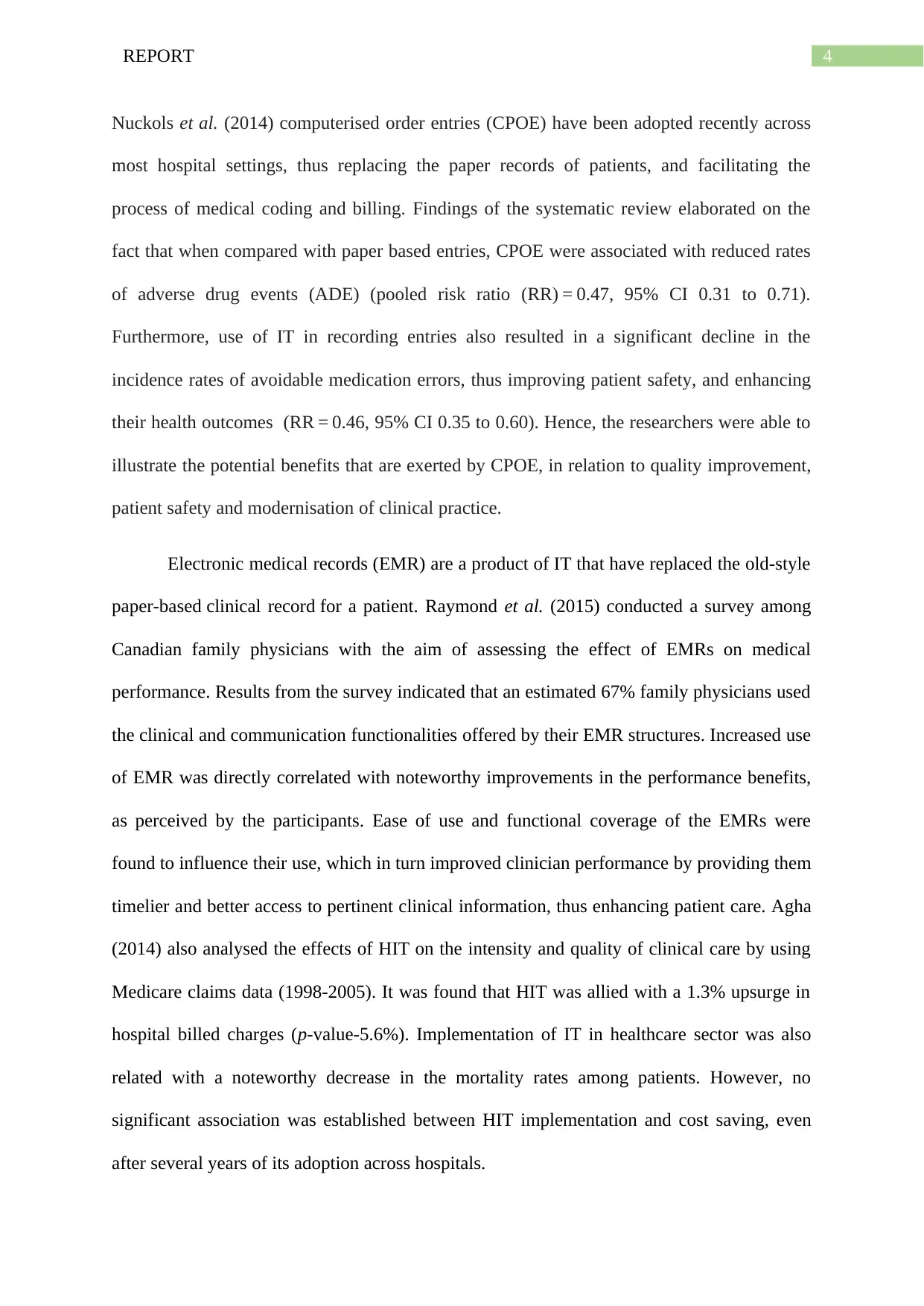
4REPORT
Nuckols et al. (2014) computerised order entries (CPOE) have been adopted recently across
most hospital settings, thus replacing the paper records of patients, and facilitating the
process of medical coding and billing. Findings of the systematic review elaborated on the
fact that when compared with paper based entries, CPOE were associated with reduced rates
of adverse drug events (ADE) (pooled risk ratio (RR) = 0.47, 95% CI 0.31 to 0.71).
Furthermore, use of IT in recording entries also resulted in a significant decline in the
incidence rates of avoidable medication errors, thus improving patient safety, and enhancing
their health outcomes (RR = 0.46, 95% CI 0.35 to 0.60). Hence, the researchers were able to
illustrate the potential benefits that are exerted by CPOE, in relation to quality improvement,
patient safety and modernisation of clinical practice.
Electronic medical records (EMR) are a product of IT that have replaced the old-style
paper-based clinical record for a patient. Raymond et al. (2015) conducted a survey among
Canadian family physicians with the aim of assessing the effect of EMRs on medical
performance. Results from the survey indicated that an estimated 67% family physicians used
the clinical and communication functionalities offered by their EMR structures. Increased use
of EMR was directly correlated with noteworthy improvements in the performance benefits,
as perceived by the participants. Ease of use and functional coverage of the EMRs were
found to influence their use, which in turn improved clinician performance by providing them
timelier and better access to pertinent clinical information, thus enhancing patient care. Agha
(2014) also analysed the effects of HIT on the intensity and quality of clinical care by using
Medicare claims data (1998-2005). It was found that HIT was allied with a 1.3% upsurge in
hospital billed charges (p-value-5.6%). Implementation of IT in healthcare sector was also
related with a noteworthy decrease in the mortality rates among patients. However, no
significant association was established between HIT implementation and cost saving, even
after several years of its adoption across hospitals.
Nuckols et al. (2014) computerised order entries (CPOE) have been adopted recently across
most hospital settings, thus replacing the paper records of patients, and facilitating the
process of medical coding and billing. Findings of the systematic review elaborated on the
fact that when compared with paper based entries, CPOE were associated with reduced rates
of adverse drug events (ADE) (pooled risk ratio (RR) = 0.47, 95% CI 0.31 to 0.71).
Furthermore, use of IT in recording entries also resulted in a significant decline in the
incidence rates of avoidable medication errors, thus improving patient safety, and enhancing
their health outcomes (RR = 0.46, 95% CI 0.35 to 0.60). Hence, the researchers were able to
illustrate the potential benefits that are exerted by CPOE, in relation to quality improvement,
patient safety and modernisation of clinical practice.
Electronic medical records (EMR) are a product of IT that have replaced the old-style
paper-based clinical record for a patient. Raymond et al. (2015) conducted a survey among
Canadian family physicians with the aim of assessing the effect of EMRs on medical
performance. Results from the survey indicated that an estimated 67% family physicians used
the clinical and communication functionalities offered by their EMR structures. Increased use
of EMR was directly correlated with noteworthy improvements in the performance benefits,
as perceived by the participants. Ease of use and functional coverage of the EMRs were
found to influence their use, which in turn improved clinician performance by providing them
timelier and better access to pertinent clinical information, thus enhancing patient care. Agha
(2014) also analysed the effects of HIT on the intensity and quality of clinical care by using
Medicare claims data (1998-2005). It was found that HIT was allied with a 1.3% upsurge in
hospital billed charges (p-value-5.6%). Implementation of IT in healthcare sector was also
related with a noteworthy decrease in the mortality rates among patients. However, no
significant association was established between HIT implementation and cost saving, even
after several years of its adoption across hospitals.
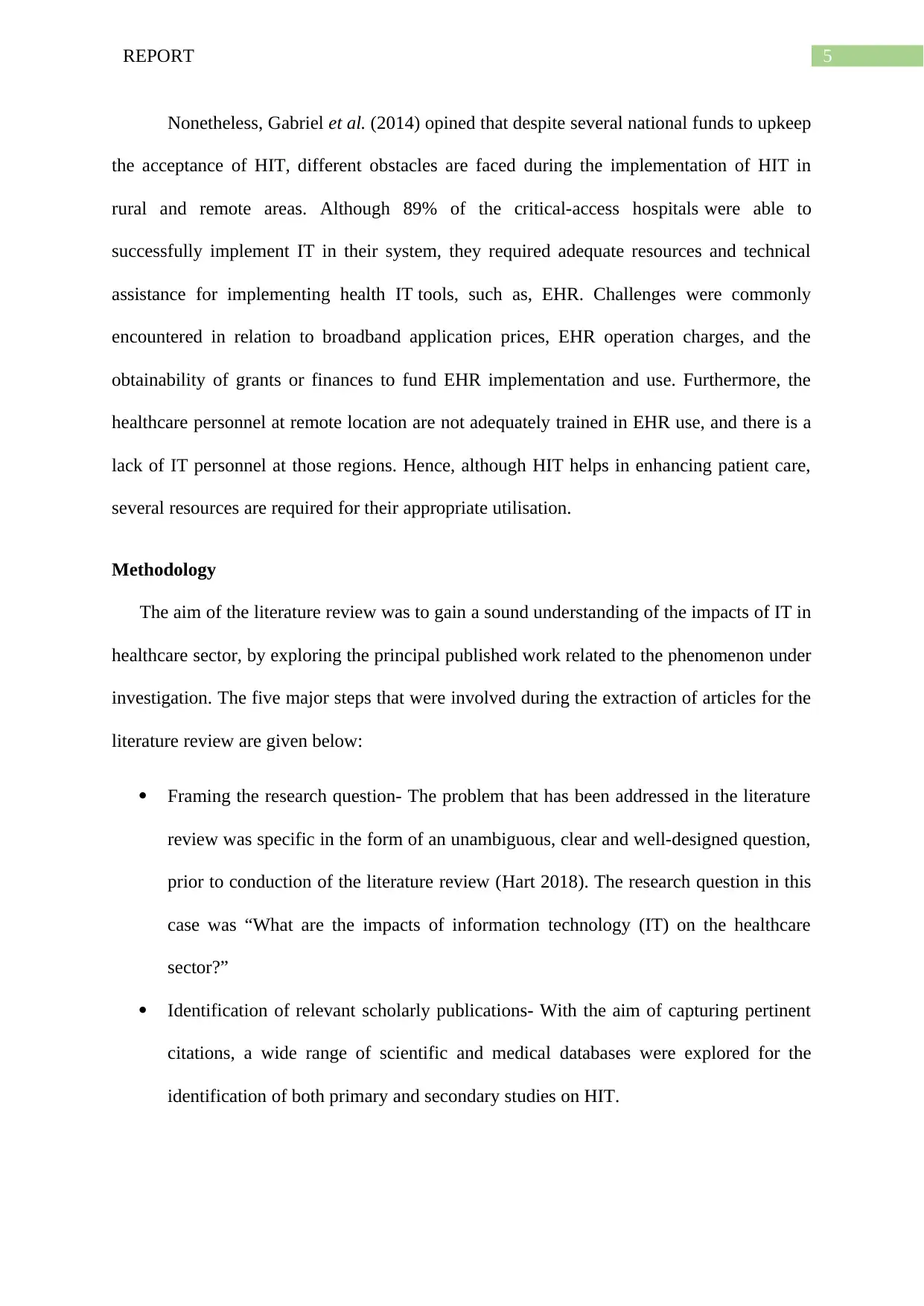
5REPORT
Nonetheless, Gabriel et al. (2014) opined that despite several national funds to upkeep
the acceptance of HIT, different obstacles are faced during the implementation of HIT in
rural and remote areas. Although 89% of the critical-access hospitals were able to
successfully implement IT in their system, they required adequate resources and technical
assistance for implementing health IT tools, such as, EHR. Challenges were commonly
encountered in relation to broadband application prices, EHR operation charges, and the
obtainability of grants or finances to fund EHR implementation and use. Furthermore, the
healthcare personnel at remote location are not adequately trained in EHR use, and there is a
lack of IT personnel at those regions. Hence, although HIT helps in enhancing patient care,
several resources are required for their appropriate utilisation.
Methodology
The aim of the literature review was to gain a sound understanding of the impacts of IT in
healthcare sector, by exploring the principal published work related to the phenomenon under
investigation. The five major steps that were involved during the extraction of articles for the
literature review are given below:
Framing the research question- The problem that has been addressed in the literature
review was specific in the form of an unambiguous, clear and well-designed question,
prior to conduction of the literature review (Hart 2018). The research question in this
case was “What are the impacts of information technology (IT) on the healthcare
sector?”
Identification of relevant scholarly publications- With the aim of capturing pertinent
citations, a wide range of scientific and medical databases were explored for the
identification of both primary and secondary studies on HIT.
Nonetheless, Gabriel et al. (2014) opined that despite several national funds to upkeep
the acceptance of HIT, different obstacles are faced during the implementation of HIT in
rural and remote areas. Although 89% of the critical-access hospitals were able to
successfully implement IT in their system, they required adequate resources and technical
assistance for implementing health IT tools, such as, EHR. Challenges were commonly
encountered in relation to broadband application prices, EHR operation charges, and the
obtainability of grants or finances to fund EHR implementation and use. Furthermore, the
healthcare personnel at remote location are not adequately trained in EHR use, and there is a
lack of IT personnel at those regions. Hence, although HIT helps in enhancing patient care,
several resources are required for their appropriate utilisation.
Methodology
The aim of the literature review was to gain a sound understanding of the impacts of IT in
healthcare sector, by exploring the principal published work related to the phenomenon under
investigation. The five major steps that were involved during the extraction of articles for the
literature review are given below:
Framing the research question- The problem that has been addressed in the literature
review was specific in the form of an unambiguous, clear and well-designed question,
prior to conduction of the literature review (Hart 2018). The research question in this
case was “What are the impacts of information technology (IT) on the healthcare
sector?”
Identification of relevant scholarly publications- With the aim of capturing pertinent
citations, a wide range of scientific and medical databases were explored for the
identification of both primary and secondary studies on HIT.
⊘ This is a preview!⊘
Do you want full access?
Subscribe today to unlock all pages.

Trusted by 1+ million students worldwide
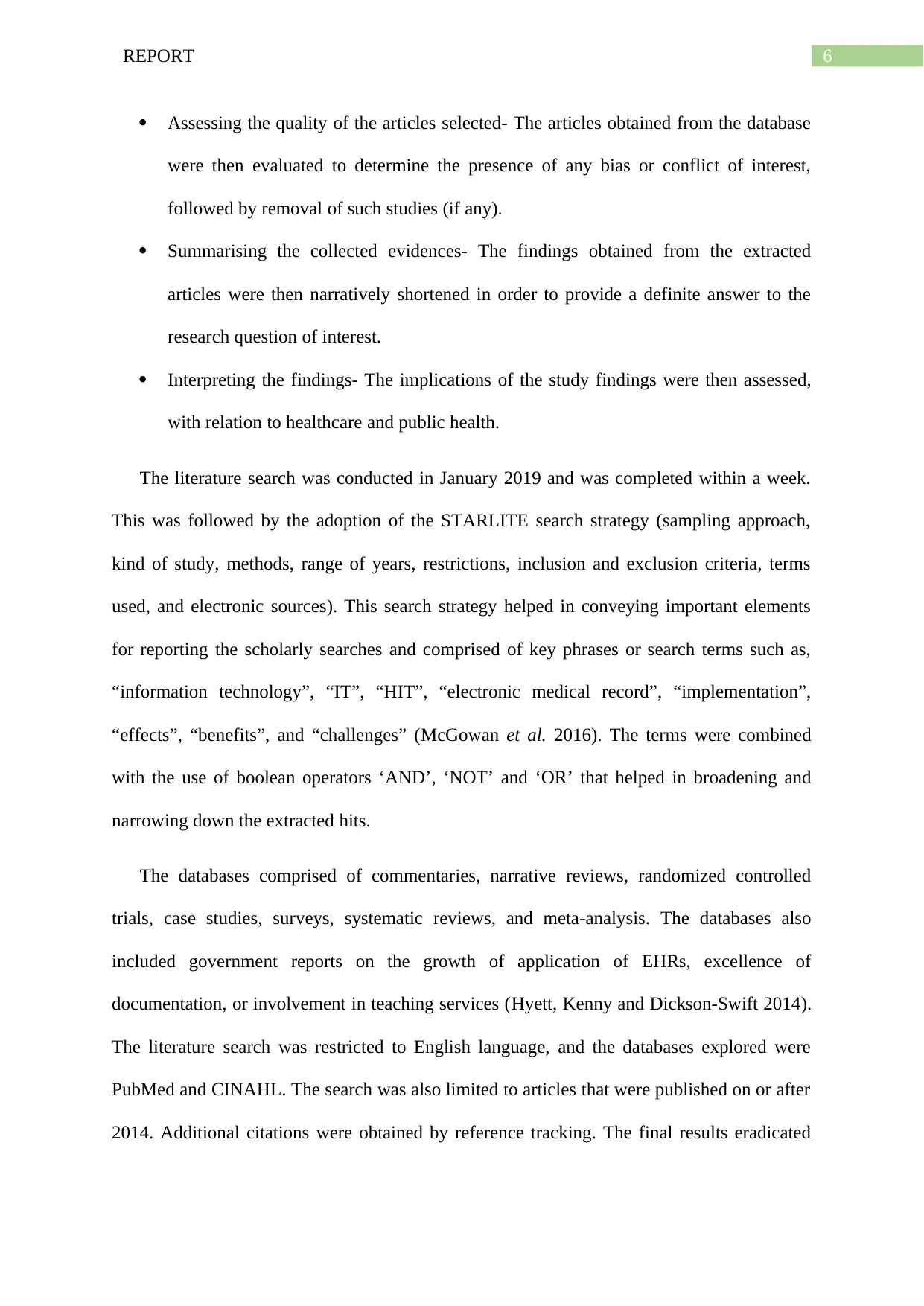
6REPORT
Assessing the quality of the articles selected- The articles obtained from the database
were then evaluated to determine the presence of any bias or conflict of interest,
followed by removal of such studies (if any).
Summarising the collected evidences- The findings obtained from the extracted
articles were then narratively shortened in order to provide a definite answer to the
research question of interest.
Interpreting the findings- The implications of the study findings were then assessed,
with relation to healthcare and public health.
The literature search was conducted in January 2019 and was completed within a week.
This was followed by the adoption of the STARLITE search strategy (sampling approach,
kind of study, methods, range of years, restrictions, inclusion and exclusion criteria, terms
used, and electronic sources). This search strategy helped in conveying important elements
for reporting the scholarly searches and comprised of key phrases or search terms such as,
“information technology”, “IT”, “HIT”, “electronic medical record”, “implementation”,
“effects”, “benefits”, and “challenges” (McGowan et al. 2016). The terms were combined
with the use of boolean operators ‘AND’, ‘NOT’ and ‘OR’ that helped in broadening and
narrowing down the extracted hits.
The databases comprised of commentaries, narrative reviews, randomized controlled
trials, case studies, surveys, systematic reviews, and meta-analysis. The databases also
included government reports on the growth of application of EHRs, excellence of
documentation, or involvement in teaching services (Hyett, Kenny and Dickson-Swift 2014).
The literature search was restricted to English language, and the databases explored were
PubMed and CINAHL. The search was also limited to articles that were published on or after
2014. Additional citations were obtained by reference tracking. The final results eradicated
Assessing the quality of the articles selected- The articles obtained from the database
were then evaluated to determine the presence of any bias or conflict of interest,
followed by removal of such studies (if any).
Summarising the collected evidences- The findings obtained from the extracted
articles were then narratively shortened in order to provide a definite answer to the
research question of interest.
Interpreting the findings- The implications of the study findings were then assessed,
with relation to healthcare and public health.
The literature search was conducted in January 2019 and was completed within a week.
This was followed by the adoption of the STARLITE search strategy (sampling approach,
kind of study, methods, range of years, restrictions, inclusion and exclusion criteria, terms
used, and electronic sources). This search strategy helped in conveying important elements
for reporting the scholarly searches and comprised of key phrases or search terms such as,
“information technology”, “IT”, “HIT”, “electronic medical record”, “implementation”,
“effects”, “benefits”, and “challenges” (McGowan et al. 2016). The terms were combined
with the use of boolean operators ‘AND’, ‘NOT’ and ‘OR’ that helped in broadening and
narrowing down the extracted hits.
The databases comprised of commentaries, narrative reviews, randomized controlled
trials, case studies, surveys, systematic reviews, and meta-analysis. The databases also
included government reports on the growth of application of EHRs, excellence of
documentation, or involvement in teaching services (Hyett, Kenny and Dickson-Swift 2014).
The literature search was restricted to English language, and the databases explored were
PubMed and CINAHL. The search was also limited to articles that were published on or after
2014. Additional citations were obtained by reference tracking. The final results eradicated
Paraphrase This Document
Need a fresh take? Get an instant paraphrase of this document with our AI Paraphraser
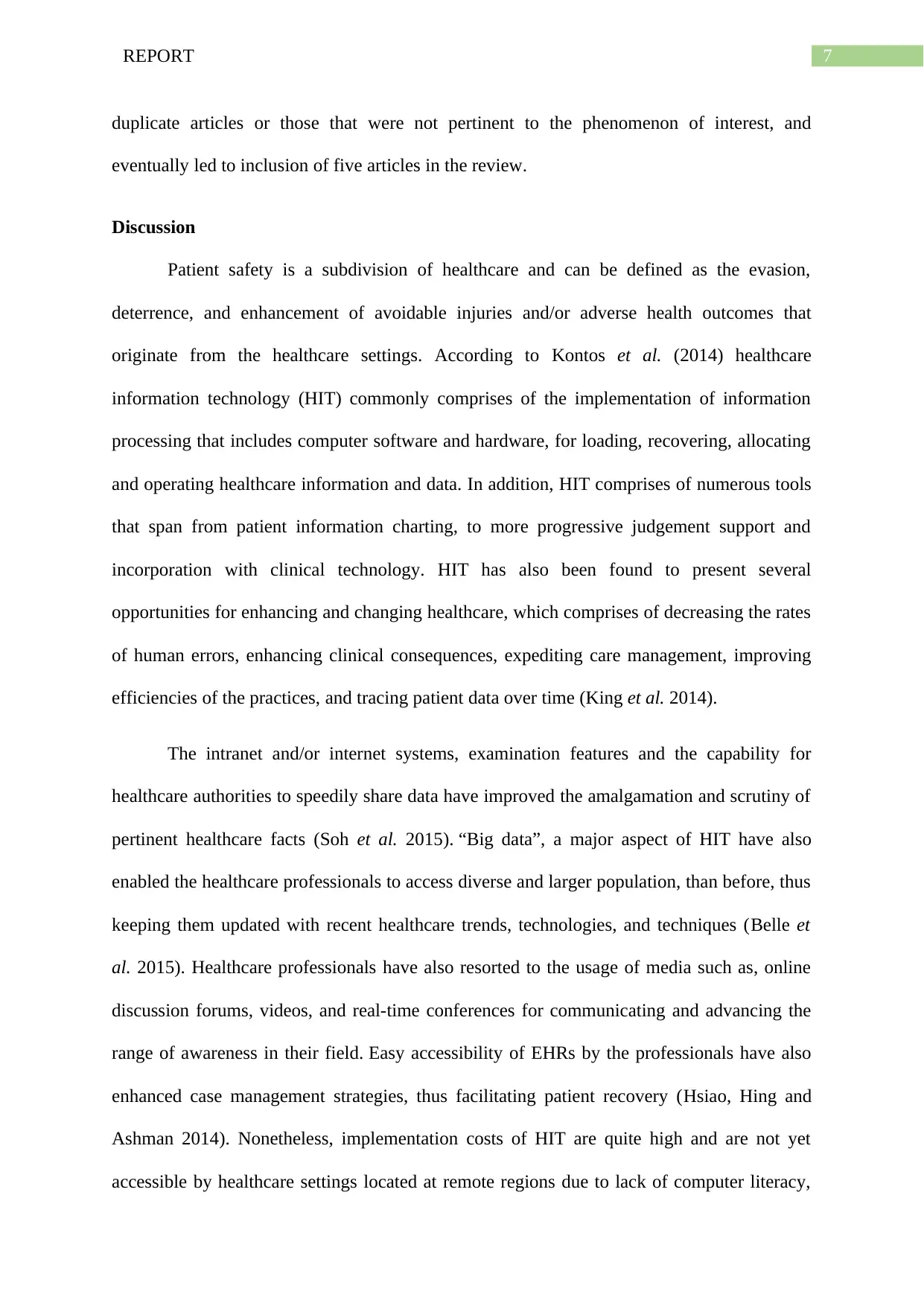
7REPORT
duplicate articles or those that were not pertinent to the phenomenon of interest, and
eventually led to inclusion of five articles in the review.
Discussion
Patient safety is a subdivision of healthcare and can be defined as the evasion,
deterrence, and enhancement of avoidable injuries and/or adverse health outcomes that
originate from the healthcare settings. According to Kontos et al. (2014) healthcare
information technology (HIT) commonly comprises of the implementation of information
processing that includes computer software and hardware, for loading, recovering, allocating
and operating healthcare information and data. In addition, HIT comprises of numerous tools
that span from patient information charting, to more progressive judgement support and
incorporation with clinical technology. HIT has also been found to present several
opportunities for enhancing and changing healthcare, which comprises of decreasing the rates
of human errors, enhancing clinical consequences, expediting care management, improving
efficiencies of the practices, and tracing patient data over time (King et al. 2014).
The intranet and/or internet systems, examination features and the capability for
healthcare authorities to speedily share data have improved the amalgamation and scrutiny of
pertinent healthcare facts (Soh et al. 2015). “Big data”, a major aspect of HIT have also
enabled the healthcare professionals to access diverse and larger population, than before, thus
keeping them updated with recent healthcare trends, technologies, and techniques (Belle et
al. 2015). Healthcare professionals have also resorted to the usage of media such as, online
discussion forums, videos, and real-time conferences for communicating and advancing the
range of awareness in their field. Easy accessibility of EHRs by the professionals have also
enhanced case management strategies, thus facilitating patient recovery (Hsiao, Hing and
Ashman 2014). Nonetheless, implementation costs of HIT are quite high and are not yet
accessible by healthcare settings located at remote regions due to lack of computer literacy,
duplicate articles or those that were not pertinent to the phenomenon of interest, and
eventually led to inclusion of five articles in the review.
Discussion
Patient safety is a subdivision of healthcare and can be defined as the evasion,
deterrence, and enhancement of avoidable injuries and/or adverse health outcomes that
originate from the healthcare settings. According to Kontos et al. (2014) healthcare
information technology (HIT) commonly comprises of the implementation of information
processing that includes computer software and hardware, for loading, recovering, allocating
and operating healthcare information and data. In addition, HIT comprises of numerous tools
that span from patient information charting, to more progressive judgement support and
incorporation with clinical technology. HIT has also been found to present several
opportunities for enhancing and changing healthcare, which comprises of decreasing the rates
of human errors, enhancing clinical consequences, expediting care management, improving
efficiencies of the practices, and tracing patient data over time (King et al. 2014).
The intranet and/or internet systems, examination features and the capability for
healthcare authorities to speedily share data have improved the amalgamation and scrutiny of
pertinent healthcare facts (Soh et al. 2015). “Big data”, a major aspect of HIT have also
enabled the healthcare professionals to access diverse and larger population, than before, thus
keeping them updated with recent healthcare trends, technologies, and techniques (Belle et
al. 2015). Healthcare professionals have also resorted to the usage of media such as, online
discussion forums, videos, and real-time conferences for communicating and advancing the
range of awareness in their field. Easy accessibility of EHRs by the professionals have also
enhanced case management strategies, thus facilitating patient recovery (Hsiao, Hing and
Ashman 2014). Nonetheless, implementation costs of HIT are quite high and are not yet
accessible by healthcare settings located at remote regions due to lack of computer literacy,
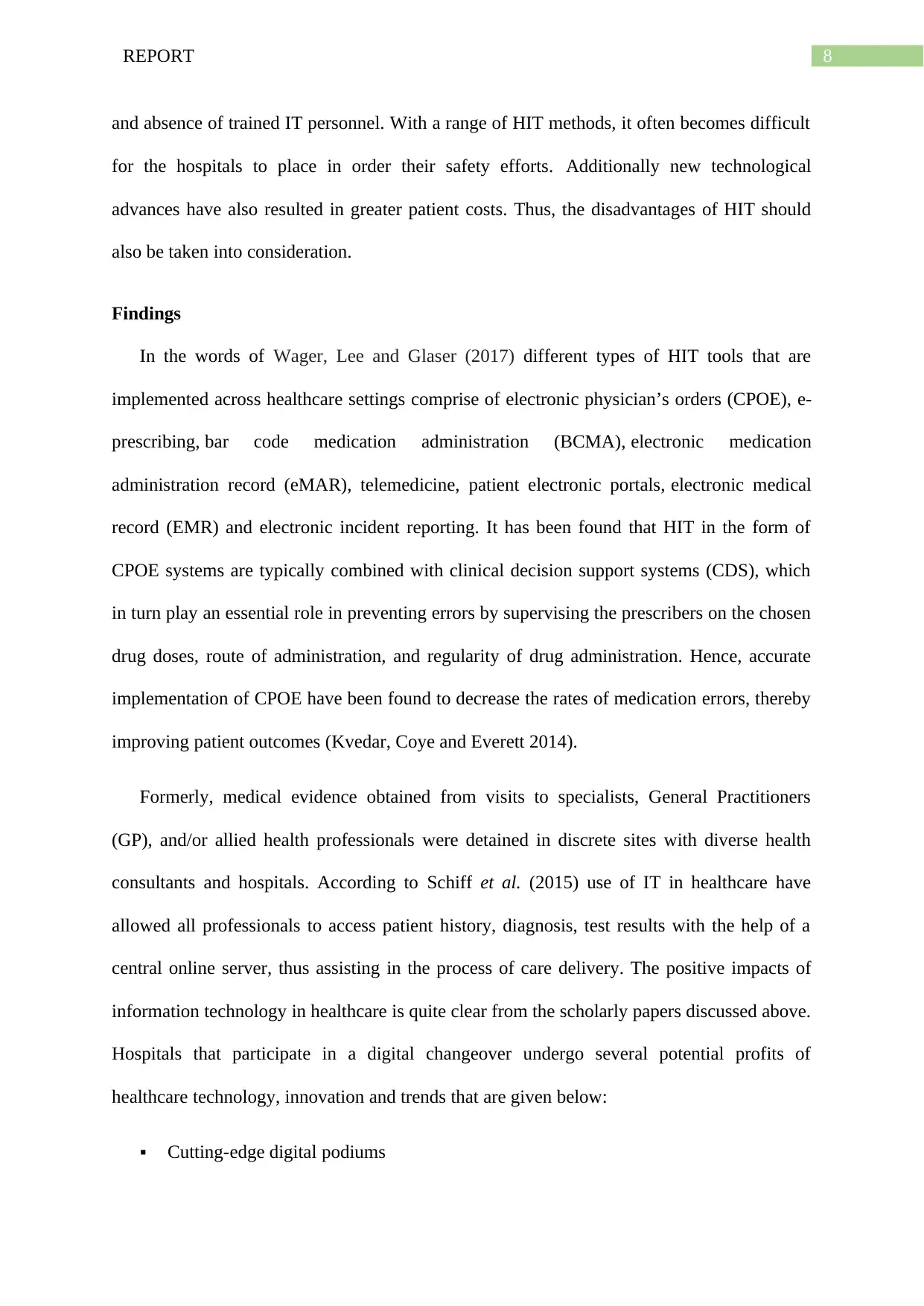
8REPORT
and absence of trained IT personnel. With a range of HIT methods, it often becomes difficult
for the hospitals to place in order their safety efforts. Additionally new technological
advances have also resulted in greater patient costs. Thus, the disadvantages of HIT should
also be taken into consideration.
Findings
In the words of Wager, Lee and Glaser (2017) different types of HIT tools that are
implemented across healthcare settings comprise of electronic physician’s orders (CPOE), e-
prescribing, bar code medication administration (BCMA), electronic medication
administration record (eMAR), telemedicine, patient electronic portals, electronic medical
record (EMR) and electronic incident reporting. It has been found that HIT in the form of
CPOE systems are typically combined with clinical decision support systems (CDS), which
in turn play an essential role in preventing errors by supervising the prescribers on the chosen
drug doses, route of administration, and regularity of drug administration. Hence, accurate
implementation of CPOE have been found to decrease the rates of medication errors, thereby
improving patient outcomes (Kvedar, Coye and Everett 2014).
Formerly, medical evidence obtained from visits to specialists, General Practitioners
(GP), and/or allied health professionals were detained in discrete sites with diverse health
consultants and hospitals. According to Schiff et al. (2015) use of IT in healthcare have
allowed all professionals to access patient history, diagnosis, test results with the help of a
central online server, thus assisting in the process of care delivery. The positive impacts of
information technology in healthcare is quite clear from the scholarly papers discussed above.
Hospitals that participate in a digital changeover undergo several potential profits of
healthcare technology, innovation and trends that are given below:
Cutting-edge digital podiums
and absence of trained IT personnel. With a range of HIT methods, it often becomes difficult
for the hospitals to place in order their safety efforts. Additionally new technological
advances have also resulted in greater patient costs. Thus, the disadvantages of HIT should
also be taken into consideration.
Findings
In the words of Wager, Lee and Glaser (2017) different types of HIT tools that are
implemented across healthcare settings comprise of electronic physician’s orders (CPOE), e-
prescribing, bar code medication administration (BCMA), electronic medication
administration record (eMAR), telemedicine, patient electronic portals, electronic medical
record (EMR) and electronic incident reporting. It has been found that HIT in the form of
CPOE systems are typically combined with clinical decision support systems (CDS), which
in turn play an essential role in preventing errors by supervising the prescribers on the chosen
drug doses, route of administration, and regularity of drug administration. Hence, accurate
implementation of CPOE have been found to decrease the rates of medication errors, thereby
improving patient outcomes (Kvedar, Coye and Everett 2014).
Formerly, medical evidence obtained from visits to specialists, General Practitioners
(GP), and/or allied health professionals were detained in discrete sites with diverse health
consultants and hospitals. According to Schiff et al. (2015) use of IT in healthcare have
allowed all professionals to access patient history, diagnosis, test results with the help of a
central online server, thus assisting in the process of care delivery. The positive impacts of
information technology in healthcare is quite clear from the scholarly papers discussed above.
Hospitals that participate in a digital changeover undergo several potential profits of
healthcare technology, innovation and trends that are given below:
Cutting-edge digital podiums
⊘ This is a preview!⊘
Do you want full access?
Subscribe today to unlock all pages.

Trusted by 1+ million students worldwide
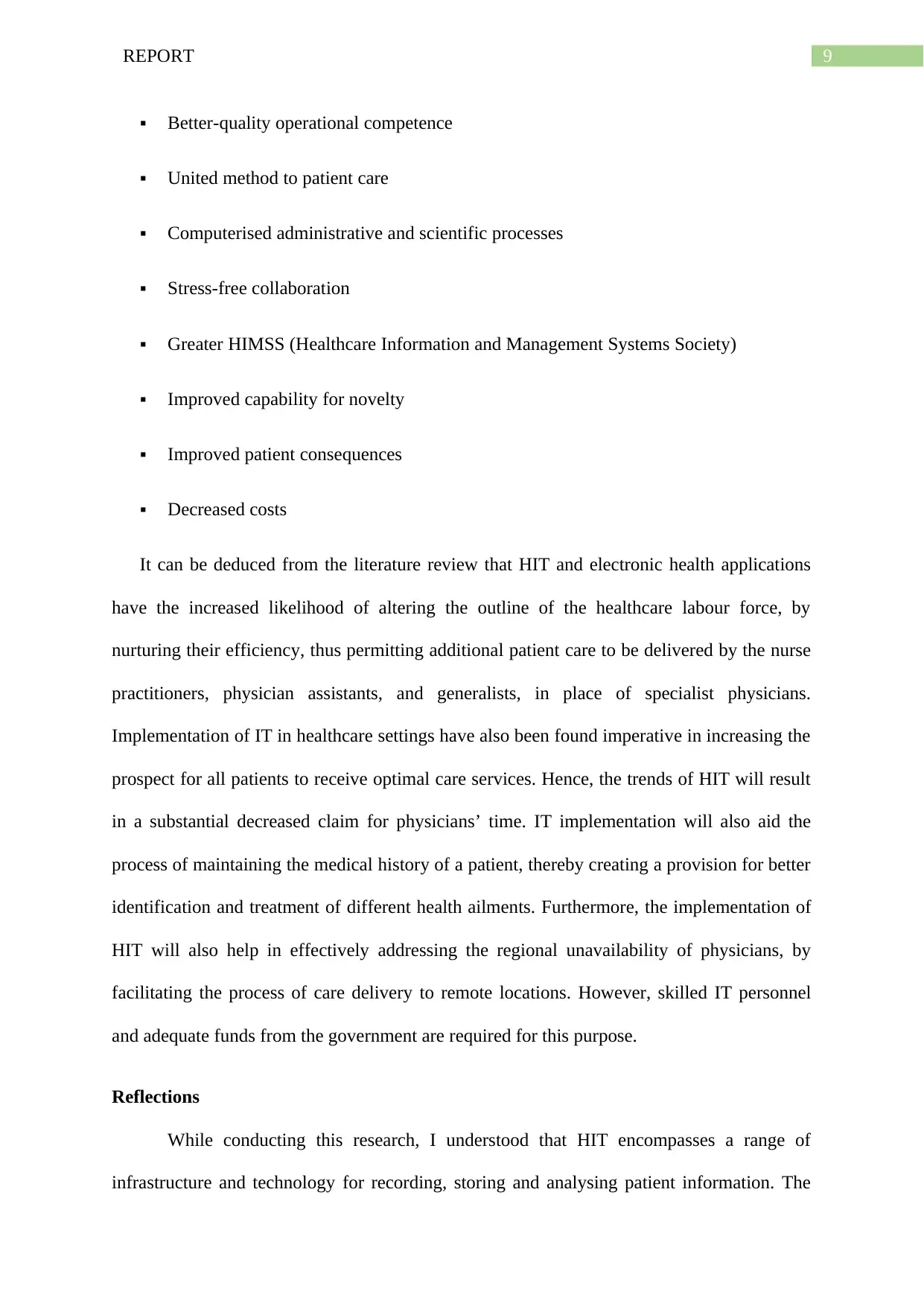
9REPORT
Better-quality operational competence
United method to patient care
Computerised administrative and scientific processes
Stress-free collaboration
Greater HIMSS (Healthcare Information and Management Systems Society)
Improved capability for novelty
Improved patient consequences
Decreased costs
It can be deduced from the literature review that HIT and electronic health applications
have the increased likelihood of altering the outline of the healthcare labour force, by
nurturing their efficiency, thus permitting additional patient care to be delivered by the nurse
practitioners, physician assistants, and generalists, in place of specialist physicians.
Implementation of IT in healthcare settings have also been found imperative in increasing the
prospect for all patients to receive optimal care services. Hence, the trends of HIT will result
in a substantial decreased claim for physicians’ time. IT implementation will also aid the
process of maintaining the medical history of a patient, thereby creating a provision for better
identification and treatment of different health ailments. Furthermore, the implementation of
HIT will also help in effectively addressing the regional unavailability of physicians, by
facilitating the process of care delivery to remote locations. However, skilled IT personnel
and adequate funds from the government are required for this purpose.
Reflections
While conducting this research, I understood that HIT encompasses a range of
infrastructure and technology for recording, storing and analysing patient information. The
Better-quality operational competence
United method to patient care
Computerised administrative and scientific processes
Stress-free collaboration
Greater HIMSS (Healthcare Information and Management Systems Society)
Improved capability for novelty
Improved patient consequences
Decreased costs
It can be deduced from the literature review that HIT and electronic health applications
have the increased likelihood of altering the outline of the healthcare labour force, by
nurturing their efficiency, thus permitting additional patient care to be delivered by the nurse
practitioners, physician assistants, and generalists, in place of specialist physicians.
Implementation of IT in healthcare settings have also been found imperative in increasing the
prospect for all patients to receive optimal care services. Hence, the trends of HIT will result
in a substantial decreased claim for physicians’ time. IT implementation will also aid the
process of maintaining the medical history of a patient, thereby creating a provision for better
identification and treatment of different health ailments. Furthermore, the implementation of
HIT will also help in effectively addressing the regional unavailability of physicians, by
facilitating the process of care delivery to remote locations. However, skilled IT personnel
and adequate funds from the government are required for this purpose.
Reflections
While conducting this research, I understood that HIT encompasses a range of
infrastructure and technology for recording, storing and analysing patient information. The
Paraphrase This Document
Need a fresh take? Get an instant paraphrase of this document with our AI Paraphraser
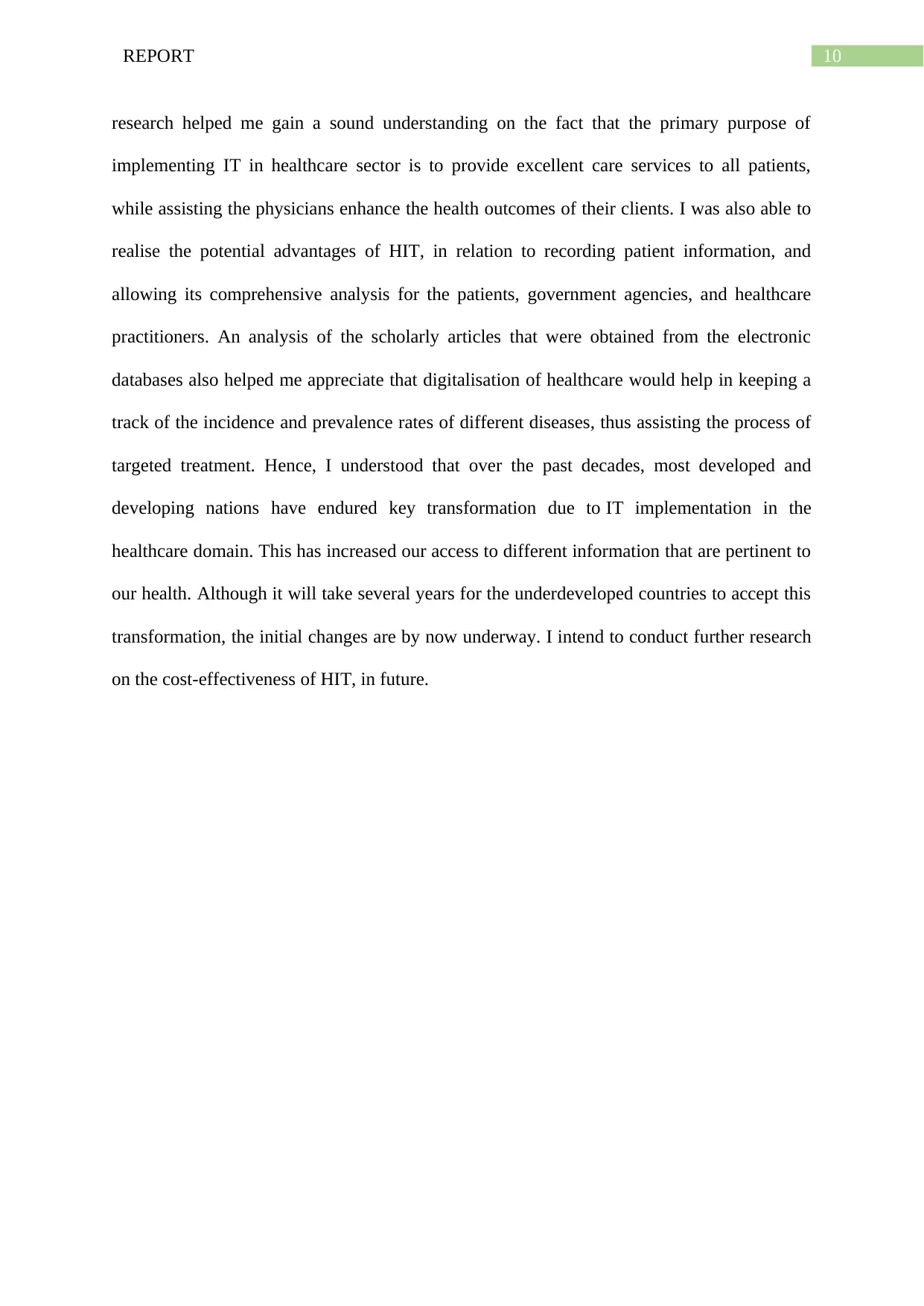
10REPORT
research helped me gain a sound understanding on the fact that the primary purpose of
implementing IT in healthcare sector is to provide excellent care services to all patients,
while assisting the physicians enhance the health outcomes of their clients. I was also able to
realise the potential advantages of HIT, in relation to recording patient information, and
allowing its comprehensive analysis for the patients, government agencies, and healthcare
practitioners. An analysis of the scholarly articles that were obtained from the electronic
databases also helped me appreciate that digitalisation of healthcare would help in keeping a
track of the incidence and prevalence rates of different diseases, thus assisting the process of
targeted treatment. Hence, I understood that over the past decades, most developed and
developing nations have endured key transformation due to IT implementation in the
healthcare domain. This has increased our access to different information that are pertinent to
our health. Although it will take several years for the underdeveloped countries to accept this
transformation, the initial changes are by now underway. I intend to conduct further research
on the cost-effectiveness of HIT, in future.
research helped me gain a sound understanding on the fact that the primary purpose of
implementing IT in healthcare sector is to provide excellent care services to all patients,
while assisting the physicians enhance the health outcomes of their clients. I was also able to
realise the potential advantages of HIT, in relation to recording patient information, and
allowing its comprehensive analysis for the patients, government agencies, and healthcare
practitioners. An analysis of the scholarly articles that were obtained from the electronic
databases also helped me appreciate that digitalisation of healthcare would help in keeping a
track of the incidence and prevalence rates of different diseases, thus assisting the process of
targeted treatment. Hence, I understood that over the past decades, most developed and
developing nations have endured key transformation due to IT implementation in the
healthcare domain. This has increased our access to different information that are pertinent to
our health. Although it will take several years for the underdeveloped countries to accept this
transformation, the initial changes are by now underway. I intend to conduct further research
on the cost-effectiveness of HIT, in future.
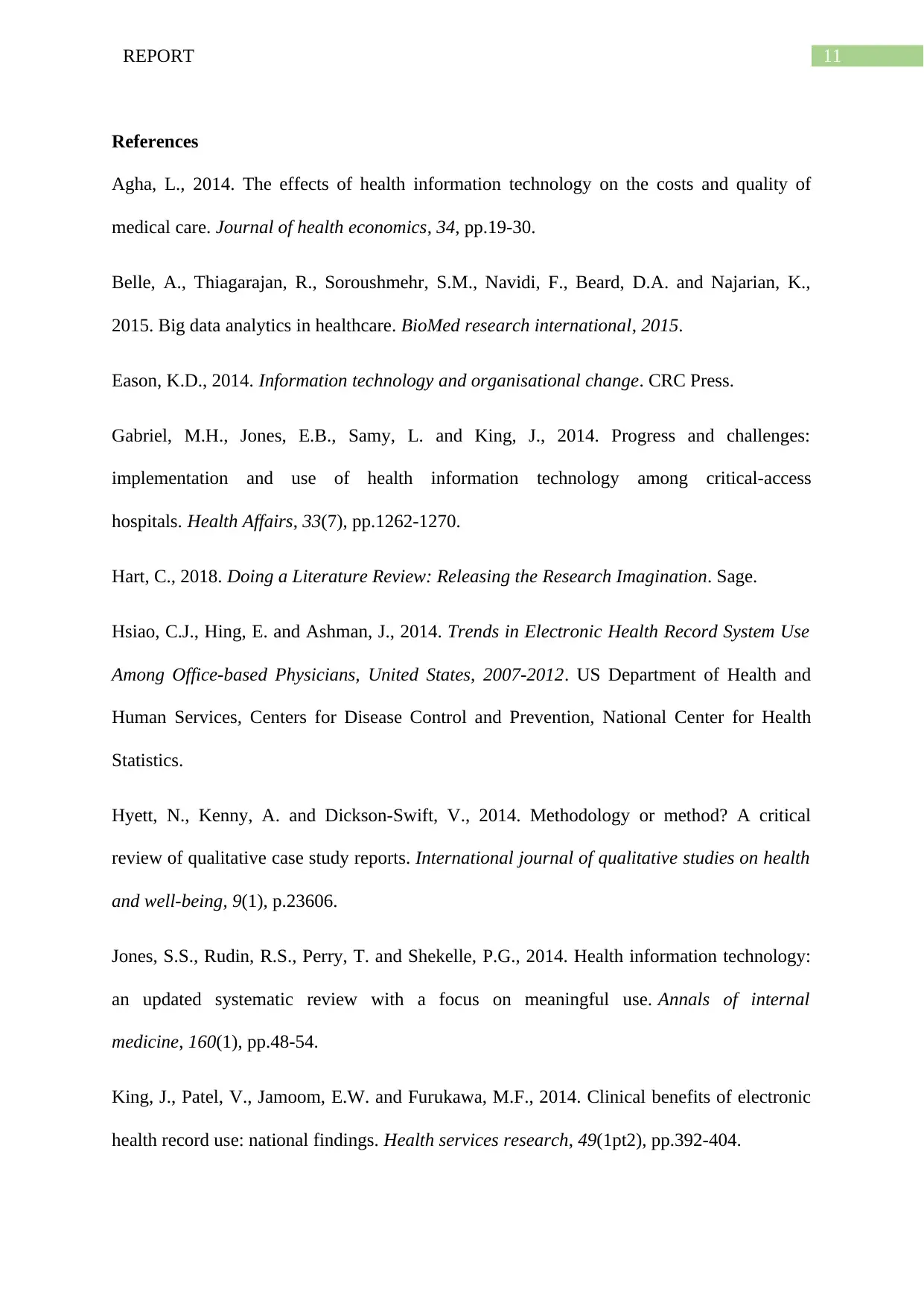
11REPORT
References
Agha, L., 2014. The effects of health information technology on the costs and quality of
medical care. Journal of health economics, 34, pp.19-30.
Belle, A., Thiagarajan, R., Soroushmehr, S.M., Navidi, F., Beard, D.A. and Najarian, K.,
2015. Big data analytics in healthcare. BioMed research international, 2015.
Eason, K.D., 2014. Information technology and organisational change. CRC Press.
Gabriel, M.H., Jones, E.B., Samy, L. and King, J., 2014. Progress and challenges:
implementation and use of health information technology among critical-access
hospitals. Health Affairs, 33(7), pp.1262-1270.
Hart, C., 2018. Doing a Literature Review: Releasing the Research Imagination. Sage.
Hsiao, C.J., Hing, E. and Ashman, J., 2014. Trends in Electronic Health Record System Use
Among Office-based Physicians, United States, 2007-2012. US Department of Health and
Human Services, Centers for Disease Control and Prevention, National Center for Health
Statistics.
Hyett, N., Kenny, A. and Dickson-Swift, V., 2014. Methodology or method? A critical
review of qualitative case study reports. International journal of qualitative studies on health
and well-being, 9(1), p.23606.
Jones, S.S., Rudin, R.S., Perry, T. and Shekelle, P.G., 2014. Health information technology:
an updated systematic review with a focus on meaningful use. Annals of internal
medicine, 160(1), pp.48-54.
King, J., Patel, V., Jamoom, E.W. and Furukawa, M.F., 2014. Clinical benefits of electronic
health record use: national findings. Health services research, 49(1pt2), pp.392-404.
References
Agha, L., 2014. The effects of health information technology on the costs and quality of
medical care. Journal of health economics, 34, pp.19-30.
Belle, A., Thiagarajan, R., Soroushmehr, S.M., Navidi, F., Beard, D.A. and Najarian, K.,
2015. Big data analytics in healthcare. BioMed research international, 2015.
Eason, K.D., 2014. Information technology and organisational change. CRC Press.
Gabriel, M.H., Jones, E.B., Samy, L. and King, J., 2014. Progress and challenges:
implementation and use of health information technology among critical-access
hospitals. Health Affairs, 33(7), pp.1262-1270.
Hart, C., 2018. Doing a Literature Review: Releasing the Research Imagination. Sage.
Hsiao, C.J., Hing, E. and Ashman, J., 2014. Trends in Electronic Health Record System Use
Among Office-based Physicians, United States, 2007-2012. US Department of Health and
Human Services, Centers for Disease Control and Prevention, National Center for Health
Statistics.
Hyett, N., Kenny, A. and Dickson-Swift, V., 2014. Methodology or method? A critical
review of qualitative case study reports. International journal of qualitative studies on health
and well-being, 9(1), p.23606.
Jones, S.S., Rudin, R.S., Perry, T. and Shekelle, P.G., 2014. Health information technology:
an updated systematic review with a focus on meaningful use. Annals of internal
medicine, 160(1), pp.48-54.
King, J., Patel, V., Jamoom, E.W. and Furukawa, M.F., 2014. Clinical benefits of electronic
health record use: national findings. Health services research, 49(1pt2), pp.392-404.
⊘ This is a preview!⊘
Do you want full access?
Subscribe today to unlock all pages.

Trusted by 1+ million students worldwide
1 out of 15
Related Documents
Your All-in-One AI-Powered Toolkit for Academic Success.
+13062052269
info@desklib.com
Available 24*7 on WhatsApp / Email
![[object Object]](/_next/static/media/star-bottom.7253800d.svg)
Unlock your academic potential
Copyright © 2020–2025 A2Z Services. All Rights Reserved. Developed and managed by ZUCOL.





